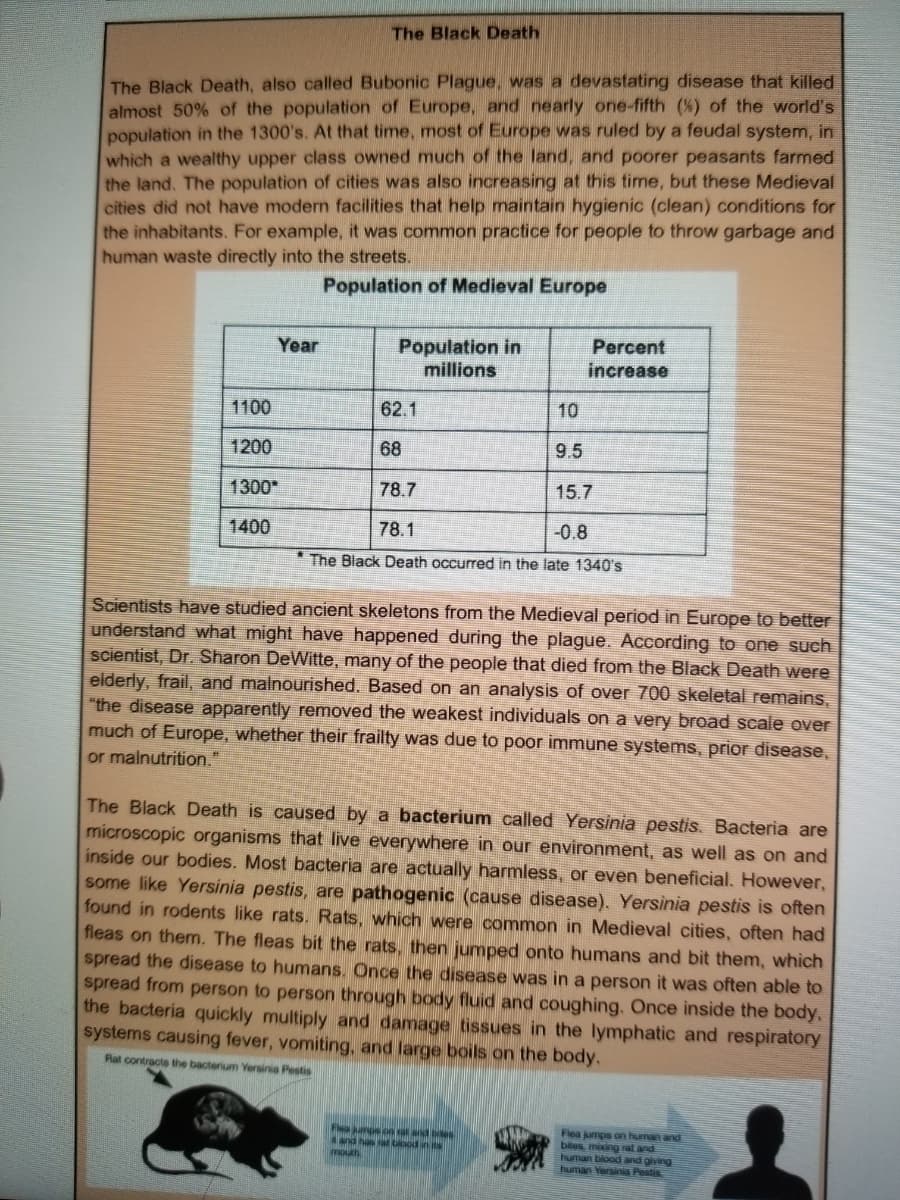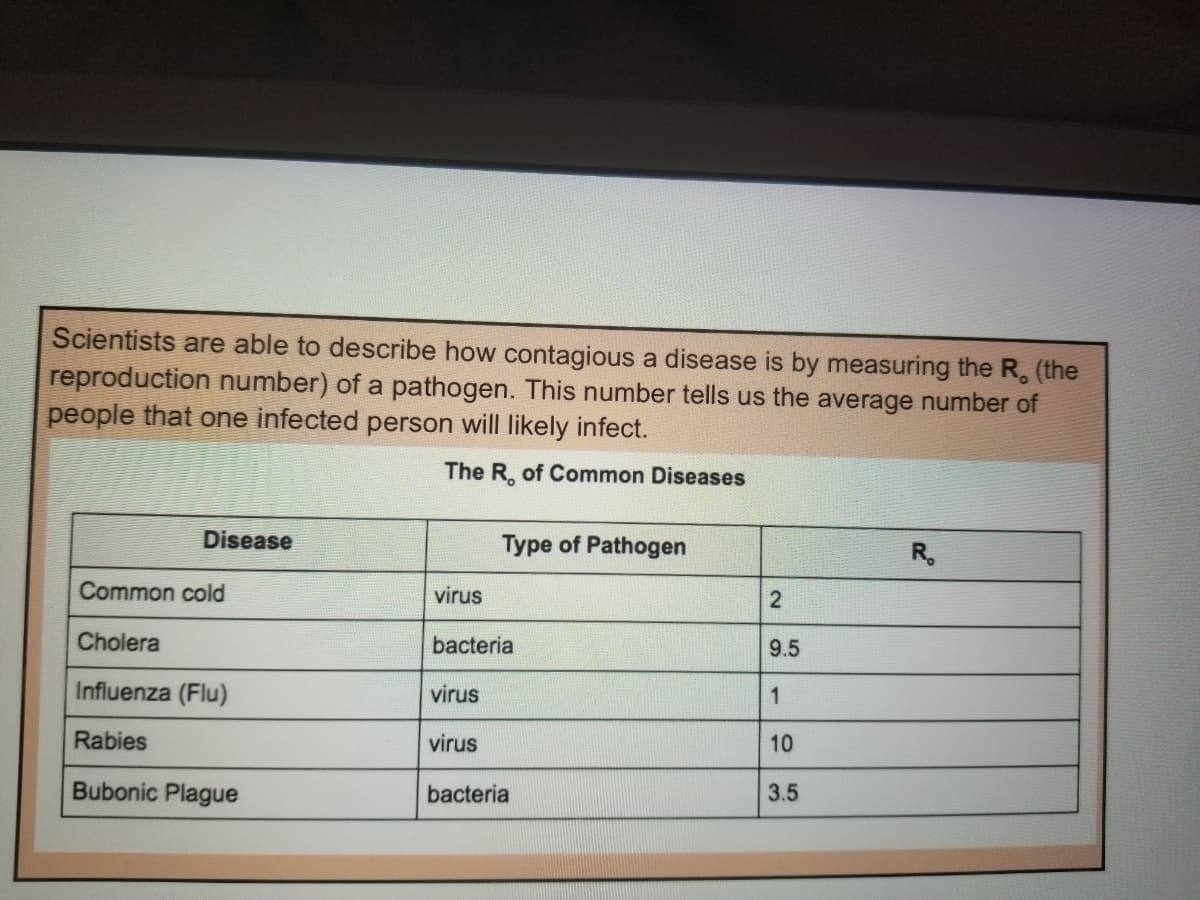The Black Death The Black Death, also called Bubonic Plague, was a devastating disease that killed almost 50% of the population of Europe, and nearly one-fifth (%) of the world's population in the 1300's. At that time, most of Europe was ruled by a feudal system, in which a wealthy upper class owned much of the land, and poorer peasants farmed the land. The population of cities was also increasing at this time, but these Medieval cities did not have modern facilities that help maintain hygienic (clean) conditions for the inhabitants. For example, it was common practice for people to throw garbage and human waste directly into the streets. Population of Medieval Europe Year Percent Population in millions increase 1100 62.1 10 1200 68 9.5 1300 78.7 15.7 1400 78.1 -0.8 The Black Death occurred in the late 1340's Scientists have studied ancient skeletons from the Medieval period in Europe to better understand what might have happened during the plague. According to one such scientist, Dr. Sharon DeWitte, many of the people that died from the Black Death were elderly, frail, and malnourished. Based on an analysis of over 700 skeletal remains, "the disease apparently removed the weakest individuals on a very broad scale over much of Europe, whether their frailty was due to poor immune systems, prior disease, or malnutrition." The Black Death is caused by a bacterium called Yersinia pestis. Bacteria are microscopic organisms that live everywhere in our environment, as well as on and inside our bodies. Most bacteria are actually harmless, or even beneficial. However, some like Yersinia pestis, are pathogenic (cause disease). Yersinia pestis is often found in rodents like rats. Rats, which were common in Medieval cities, often had fleas on them. The fleas bit the rats, then jumped onto humans and bit them, which spread the disease to humans. Once the disease was in a person it was often able to spread from person to person through body fluid and coughing. Once inside the body, the bacteria quickly multiply and damage tissues in the lymphatic and respiratory systems causing fever, vomiting, and large boils on the body. Rat contracts the bacterium Yersinia Pestis Flea jumpe on al and bies Tand has a bibod in is mouth Flea jumps on human and bites mixing rat and human blood and giving human Yersinia Pestis
The Black Death The Black Death, also called Bubonic Plague, was a devastating disease that killed almost 50% of the population of Europe, and nearly one-fifth (%) of the world's population in the 1300's. At that time, most of Europe was ruled by a feudal system, in which a wealthy upper class owned much of the land, and poorer peasants farmed the land. The population of cities was also increasing at this time, but these Medieval cities did not have modern facilities that help maintain hygienic (clean) conditions for the inhabitants. For example, it was common practice for people to throw garbage and human waste directly into the streets. Population of Medieval Europe Year Percent Population in millions increase 1100 62.1 10 1200 68 9.5 1300 78.7 15.7 1400 78.1 -0.8 The Black Death occurred in the late 1340's Scientists have studied ancient skeletons from the Medieval period in Europe to better understand what might have happened during the plague. According to one such scientist, Dr. Sharon DeWitte, many of the people that died from the Black Death were elderly, frail, and malnourished. Based on an analysis of over 700 skeletal remains, "the disease apparently removed the weakest individuals on a very broad scale over much of Europe, whether their frailty was due to poor immune systems, prior disease, or malnutrition." The Black Death is caused by a bacterium called Yersinia pestis. Bacteria are microscopic organisms that live everywhere in our environment, as well as on and inside our bodies. Most bacteria are actually harmless, or even beneficial. However, some like Yersinia pestis, are pathogenic (cause disease). Yersinia pestis is often found in rodents like rats. Rats, which were common in Medieval cities, often had fleas on them. The fleas bit the rats, then jumped onto humans and bit them, which spread the disease to humans. Once the disease was in a person it was often able to spread from person to person through body fluid and coughing. Once inside the body, the bacteria quickly multiply and damage tissues in the lymphatic and respiratory systems causing fever, vomiting, and large boils on the body. Rat contracts the bacterium Yersinia Pestis Flea jumpe on al and bies Tand has a bibod in is mouth Flea jumps on human and bites mixing rat and human blood and giving human Yersinia Pestis
Concepts of Biology
1st Edition
ISBN:9781938168116
Author:Samantha Fowler, Rebecca Roush, James Wise
Publisher:Samantha Fowler, Rebecca Roush, James Wise
Chapter1: Introduction To Biology
Section: Chapter Questions
Problem 1ACQ: Figure 1.8 Which of the following statements is false? A. Tissues exist within organs which exist...
Related questions
Question
Using evidence from the text, what factors influenced the survival of humans during the bubonic plague? PLEASE DONT COPY FROM GOOGLE USE THE TEXT!!!!!

Transcribed Image Text:The Black Death
The Black Death, also called Bubonic Plague, was a devastating disease that killed
almost 50% of the population of Europe, and nearly one-fifth (%) of the world's
population in the 1300's. At that time, most of Europe was ruled by a feudal system, in
which a wealthy upper class owned much of the land, and poorer peasants farmed
the land. The population of cities was also increasing at this time, but these Medieval
cities did not have modern facilities that help maintain hygienic (clean) conditions for
the inhabitants. For example, it was common practice for people to throw garbage and
human waste directly into the streets.
Population of Medieval Europe
Percent
Population in
millions
Year
increase
1100
62.1
10
1200
68
9.5
1300
78.7
15.7
1400
78.1
-0.8
The Black Death occurred in the late 1340's
Scientists have studied ancient skeletons from the Medieval period in Europe to better
understand what might have happened during the plague. According to one such
scientist, Dr. Sharon DeWitte, many of the people that died from the Black Death were
elderly, frail, and malnourished. Based on an analysis of over 700 skeletal remains,
"the disease apparently removed the weakest individuals on a very broad scale over
much of Europe, whether their frailty was due to poor immune systems, prior disease,
or malnutrition."
The Black Death is caused by a bacterium called Yersinia pestis. Bacteria are
microscopic organisms that live everywhere in our environment, as well as on and
inside our bodies. Most bacteria are actually harmless, or even beneficial. However,
some like Yersinia pestis, are pathogenic (cause disease). Yersinia pestis is often
found in rodents like rats. Rats, which were common in Medieval cities, often had
fleas on them. The fleas bit the rats, then jumped onto humans and bit them, which
spread the disease to humans. Once the disease was in a person it was often able to
spread from person to person through body fluid and coughing. Once inside the body,
the bacteria quickly multiply and damage tissues in the lymphatic and respiratory
systems causing fever, vomiting, and large boils on the body.
Rat contracts the bacterium Yersinia Pestis
Flea ps on at and bies
and has a bood in its
mouth
Flea jumps on human and
bites mixing rat and
human blood and giving
human Yersinia Pestis

Transcribed Image Text:Scientists are able to describe how contagious a disease is by measuring the R, (the
reproduction number) of a pathogen. This number tells us the average number of
people that one infected person will likely infect.
The R, of Common Diseases
Disease
Type of Pathogen
R.
Common cold
virus
2
Cholera
bacteria
9.5
Influenza (Flu)
virus
1
Rabies
virus
10
Bubonic Plague
bacteria
3.5
Expert Solution
This question has been solved!
Explore an expertly crafted, step-by-step solution for a thorough understanding of key concepts.
This is a popular solution!
Trending now
This is a popular solution!
Step by step
Solved in 2 steps

Knowledge Booster
Learn more about
Need a deep-dive on the concept behind this application? Look no further. Learn more about this topic, biology and related others by exploring similar questions and additional content below.Recommended textbooks for you

Concepts of Biology
Biology
ISBN:
9781938168116
Author:
Samantha Fowler, Rebecca Roush, James Wise
Publisher:
OpenStax College


Basic Clinical Lab Competencies for Respiratory C…
Nursing
ISBN:
9781285244662
Author:
White
Publisher:
Cengage

Concepts of Biology
Biology
ISBN:
9781938168116
Author:
Samantha Fowler, Rebecca Roush, James Wise
Publisher:
OpenStax College


Basic Clinical Lab Competencies for Respiratory C…
Nursing
ISBN:
9781285244662
Author:
White
Publisher:
Cengage

Biology Today and Tomorrow without Physiology (Mi…
Biology
ISBN:
9781305117396
Author:
Cecie Starr, Christine Evers, Lisa Starr
Publisher:
Cengage Learning